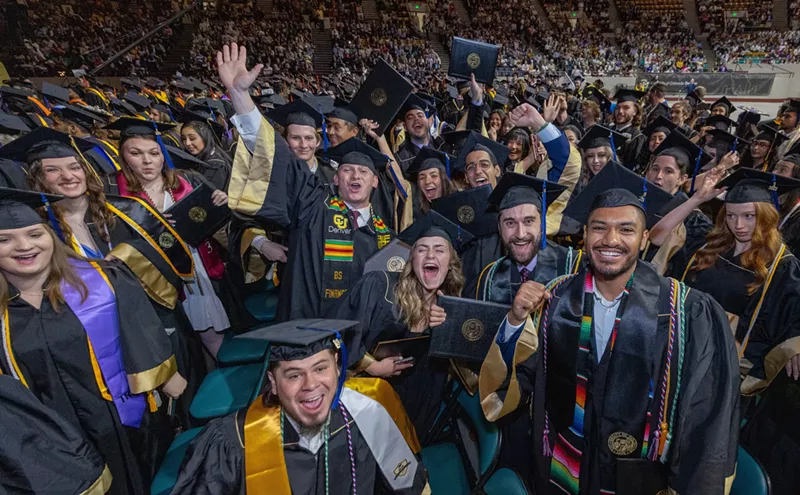This remark takes on extra resonance when viewed in the context of an e-mail addressed to Post editor Greg Moore and Carla Kimbrough-Robinson, the paper's associate editor/staff development, on November 7. Written by Aguilar and signed by Griego and six other Post employees, including Elizabeth Aguilera, Regina Avila, Angela Cortez and Andy Vuong (an Asian-American), the note takes on the topic of diversity.
"This is to inquire about how many Latino and Asian-American candidates are in the pipeline for Denver Post jobs," Aguilar's letter begins. "If we can help find more top contenders, we'd be happy to do so. As you know, Latinos make up a third of Denver's population and 17 percent of the state. Further, Latinos have a deep and rich history in Colorado. The Asian population grew 67 percent in Colorado between 1990 and 2000, which surpasses their 48 percent growth nationally. I think we all agree the newsroom staff needs to reflect that reality in order to best serve our readers.... But the Post has recently declined in the number of Asian-Americans and Latinos in the newsroom, and that is not good."
When viewed as a whole, the e-mail emerges as more constructive than confrontational, and Moore's reply, sent on November 8, echoes this tone. "I am aware of the importance of having people of different backgrounds, races, etc., in a newsroom and have a deep desire to accomplish that," Moore wrote. "I am always interested in hearing from staff members about talented professionals who might be candidates to join our staff -- especially people of color.... We are committed to recruiting a talented and diverse group of journalists to the Post. Rest assured that I hear what you are saying."
That anything was said to Moore at all is a modest surprise. By any measure, he's one of the most powerful African-American editors in the country and is known nationally for his dedication to luring a wide range of individuals into the print-journalism profession. As proof of this reputation, Moore was asked to chair the "diversity committee" assembled under the auspices of the American Society of Newspaper Editors (ASNE) even before he stepped up to the Post; at the time, he was managing editor of the Boston Globe.
On top of that, the Post's record of minority hiring prior to Moore's arrival was considerably better than that of its principal rival, if considerably short of record-setting. An April report on the ASNE Web site, www.asne.org, showed that 16.3 percent of the Post's staff consisted of minorities, as opposed to just 8.9 percent at the Rocky. (The percentage at Westword would be lower still.) In other words, the Post would seem like the last place in Colorado anyone would expect questions about the role of diversity in hiring practices to arise.
But a glance at figures provided by Moore shows why Aguilar and company are concerned. Moore has brought fourteen people aboard since joining the Post in June. Five of these hires are African-Americans, and six are women -- and since these groups have often been underrepresented in newsrooms, it's hard to argue that their presence there is anything other than laudable. But none of the new Posters are Latino or Asian-American.
This wouldn't have been the case had Moore gotten his way. "Before we could offer a job to another Latina, she was given the assignment at her paper that she had been seeking for months. She got that assignment the day after returning from her visit with us," he points out. "We also offered an assistant managing editor position to an Asian, and a week later, she was promoted to the same job at her paper."
In his e-mail, Aguilar acknowledged the attempt to sign up the Asian-American editor, as well as efforts to hire two Latino reporters for the Post's city desk. But he also stated that he and another staffer, Emily Narvaes, identified "four solid candidates" during a recent recruiting visit to a conference staged in San Diego by the National Association of Hispanic Journalists (NAHJ), "one of whom remains keenly interested. But there seems to have been little follow up with some of these candidates since the conference."
Left unstated is the crux of the matter: The Post successfully romanced a quintet of African-Americans but crapped out entirely when it came to Asian-Americans and Latinos. This batting average made Aguilar wonder if Moore had some of the "East Coast mentality" about hiring that he associates with the Washington Post, where the reporter worked before returning to Denver. (In addition, Aguilar was part of Westword's staff in the early '90s and penned a profile of Westword editor Patricia Calhoun for the Post in October.)
"The Washington Post is one of the greatest papers on the planet," Aguilar says. "But in terms of seeing beyond black and white to see Latinos and Asian-Americans, it was stuck in the 1960s. I realized that part of it was because African-Americans had fought so long and so hard to get numbers at the paper that they weren't really willing to share at that point; they were just achieving victories that should have been won a long time ago. But it was still very frustrating."
Columnist Juan Gonzalez hears observations like these every day. A fifteen-year veteran of the New York Daily News, he's also the president of the NAHJ, an organization formed in 1984 that presently boasts around 1,700 members -- a total that might be a lot higher, Gonzalez believes, if the journalism industry paid greater attention to Latino recruitment. "People have historically looked at the issues of discrimination and diversity in terms of black and white. And a lot of people haven't caught up to the fact that America has changed dramatically in the last fifty years; you have many more Hispanics and Asians in the country than ever before. But the numbers being hired by newspapers aren't keeping pace to reflect our changing communities."
According to its Web site, www.nahj.org, the NAHJ has a five-fold mission, including "to further employment and career development for Hispanics working in the news media" and to foster understanding of the culture. For instance, the group recently called on the media to stop using "Hispanic" as a physical description, since it is an ethnicity, not a race. As its press release states, "Our physical features are varied to the extent that the term 'Hispanic' conveys no distinct physical information. Some of us look like baseball player Sammy Sosa. Others look like actor Andy Garcia."
More Hispanics in newsrooms would undoubtedly lead to greater sensitivity in matters like these, but the group has a long way to go to reverse current trends. NAHJ statistics show that Latinos account for just 3.8 percent of daily newspaper personnel nationwide and only 6.1 percent of those employed by English-language television stations. In October, the NAHJ board set goals intended to boost these figures; by 2008, members want Hispanics to fill 7.8 percent of daily newspaper positions and 9 percent of the slots at English-language TV operations.
For journalism outlets to hit these targets, they must find first-rate job candidates, and accounts differ about how difficult it is to do so. Post editor Moore stops short of saying there's a shortage of qualified Hispanic reporters, but he notes that "it's very competitive, and I've found that to do it well, you've got to really be able to up the ante quite a bit. A lot of Latino journalists have their choice of where they want to work, because with the demographic changes, people are really clamoring for them. It's a tough market, which means you have to compete harder for them."
That sounds fine to Gonzalez, who has a positive impression of Moore; earlier this fall, the two of them were part of a panel discussion in Cleveland about minorities in journalism. (Gonzalez stresses that his comments are about newspapering as a whole, not Moore or the Denver Post in particular.) Still, he sees the alleged shortage of Latino and Asian-American journalists as something of a myth.
"There are a lot of reporters who work for the Spanish-language press and also for Chinese-language newspapers and publications like that, but they write English well and are looking to break into English-language papers," Gonzalez says. "Yet for the most part, they're not even considered part of the potential pool, which is a shame, especially if you consider the history of African-American journalists. Many of them came to mainstream dailies from what was then known as the black press -- and the same thing could be happening now for Hispanics and Asian-Americans if more editors thought outside the box."
Doing so might also help newspapers retain more Hispanics over the long haul -- but Gonzalez says not enough is being done in this respect, either. "In one year, 650 Latinos were hired at newspapers, but 646 left, giving us a net gain of four. So not only does hiring need to be increased, but newspapers need to find a way to keep people from going somewhere else because they don't think they're progressing. The problem is, newspapers hire one or two Hispanics and think they've done a great job, even if they have a hundred people in the newsroom. And then they don't give their Hispanic journalists enough opportunities to move up -- and after five or eight years of not being considered for better positions, they get alienated and leave."
Gonzalez feels this state of affairs is made worse by shortsighted business decisions. "These are my opinions, not the NAHJ's," he says. "But the last time I looked, newspapers have been losing their audiences for the past thirty years, and a lot of it is planned shrinkage. It happened right there in Denver. When the two papers were competing, they had huge circulations, but as soon as they entered into a shared duopoly, the circulation dropped, and they seem fine with that.
"Why?" he asks. "Because newspapers in general have pretty much decided that minorities aren't a concern of theirs. They think it costs too much money to put the paper in the hands of a working-class Hispanic and that they'll make more money if they get upscale suburbanites to buy the newspapers. So they orient the coverage to what they think the upscale suburbanites would want. They'd rather concentrate on the suburbs and let blacks and Latinos get their news from TV."
If true, Latinos are getting the stick's short end in another way. A just-released NAHJ study of 16,000 news programs aired in 2001 by ABC, CBS, NBC and CNN showed that only 99, or less than 1 percent, centered on Hispanics.
For his part, Moore has given prominent play in the Post to a multitude of stories about people of color. Reporter Aguilar cites an intriguing Diedtra Henderson article that ran on the front page of the Sunday, November 17, Post as both an example of the paper's commitment and proof that reporters with diverse backgrounds can unearth information others can't. "It was a really cool story about a black-owned business in Five Points, and Diedtra happens to be black and she lives in Five Points, which isn't a coincidence. If we have enough Latinos, we can get those kinds of great stories, too, just by hanging out with who we hang out with and talking to people in our communities."
Beyond that, says Elizabeth Aguilera, a Post feature writer, Latinos in the newsroom can help make articles that don't specifically revolve around Hispanics more accessible to them. Prior to joining the Post staff earlier this year, Aguilera worked at the Long Beach Press-Telegram and the Orange County Register, and especially at the Register, she says, "The editors would think about the Latino community when we were doing all kinds of stories. It didn't happen all the time, but often they would ask, 'Are we talking about how the Latino community is dealing with this issue? Is there a way we can reach out to them?' And I don't find that here nearly as much.
"I feel diversity in the newsroom helps newspapers truly reflect the community," she elaborates. "Adding people of color to the staff increases our visibility in the communities of color, but it also brings an awareness to the non-minority staffers in the newsroom. It prompts conversation and discussion. Right now, many newspapers in the country are grappling with this issue or giving it lip service. But the bottom line is that many papers are sharing white, middle- to upper-class views, issues and concerns with readers and dissing Latinos and Asians. A bad move, really, because these folks are our future readers. It's also a disservice to readers overall, because newspapers miss out on opportunities to help neighbors get to know neighbors through our reporting and writing."
Aguilera is hopeful that Moore will be part of the solution to these problems; in fact, she says his openness about such matters "made us comfortable about approaching him" via the Aguilar-penned e-mail. Furthermore, she was heartened by his response, as were Avila, an assistant librarian at the Post, and Vuong, a business writer. But all three would be happier still if more Latinos and/or Asian-Americans were hired.
Obviously, all eyes will be on Moore to see what happens next. He just hired Gary Clark, a Caucasian colleague from his days at the Cleveland Plain Dealer, to serve as managing editor, replacing the departed Larry Burrough, but Moore points out that the paper has five Hispanic editors spread across its production and assignment departments, as well as an Asian-American designer. He hints that more Latinos and Asian-Americans may join them.
"Being an African-American and being the editor here, I think there's a high expectation that we'll be committed to diversity, and I am," he says. "There are talented journalists of color out there, and we don't have to bend the rules or tilt the playing field to find them. I think we're well on our way."
He emphasizes that the message delivered by Aguilar and others came through loud and clear. "I understand what they're saying, and I think it's a legitimate issue. We're going to redouble our efforts."
Special delivery: Most e-mails reach their intended destinations, as was the case with the Louis Aguilar note in the item above. But plenty go awry, too -- and when it comes to journalism, misdirected missives can have unintended consequences. Ask Post city editor Evan Dreyer, who accidentally sent an unflattering personnel assessment of a departing employee to most of the paper's editorial staff ("Getting Racked," September 12).
I'm certainly not immune from such gaffes. In last week's column, I wrote that Rocky Mountain News columnist Bill Johnson hadn't replied to interview requests; because his voice mail was full for the better part of a week, I sent him a pair of e-mails that went unreturned. Days later, Johnson wrote me a note calling this assertion "bush," since he hadn't received my queries. After some investigation, I discovered that I'd shipped the e-mails to [email protected], assuming that he was listed in the Rocky system under "Bill." Actually, his address is [email protected], because he's known by the paper's Webmaster (and probably on his birth certificate) as "William." How formal.
Fortunately, my screwup was matched by one of Johnson's News colleagues, managing editor Deb Goeken. On a Friday in late November, she assembled an e-mail containing information about the paper's proposed story lineup for the following Monday and attempted to direct it to Vikki Migoya, the assistant city editor working on the News's night crew. But the joint operating agreement between the News and the Denver Post didn't only merge business operations at the papers; it also led to the combining of the e-mail system. As a result, Goeken's e-mail wound up going to Vikki's husband, David Migoya, a reporter for the Denver Post. Goeken knows that to be true, since David sent it back to her along with a note guessing that the e-mail was probably meant for Vikki.
The tale might have ended there were it not for a certain coincidence. Rocky reporter Robert Sanchez had put a lot of time and toil into a package of stories about a cop shortage at the Denver Police Department, which had taken to raiding smaller forces for talent. But what Sanchez hoped would be an exclusive turned out to be something less; on the same day, the Post's Sean Kelly wrote a shorter, less in-depth version on the same subject.
Before long, rumors starting circulating around the News that Kelly's article had sprung to life only after he'd learned about Sanchez's reports from e-mail recipient David Migoya. But that couldn't have been the case, since David kept the e-mail's content to himself. "If I learned of what the Rocky was up to on any topic during the course of my daily reporting on a story, I obviously and probably rightfully would have shared that with anybody at our paper, to give them a heads-up," David says. "However, this was a little different. Because of my personal relationship with one of my competitors" -- meaning his wife -- "the way the e-mail came to me wouldn't have made it right for me to have done anything other than what I did, which was not to share it."
David subsequently learned that Kelly's article was already scheduled for the Monday Post anyhow, which doesn't surprise Goeken. "We had heard they were working on it," she says. "Of course, Robert Sanchez was upset when the Post had it as well, even though they didn't have nearly as good a story as we did; they had just a little story that they buried inside." Nonetheless, she asked Mike Noe, the head of the News's new media department, "to help me limit the toolbox on my e-mail to only people at the Rocky. He knew how to do it and I didn't, so that should take care of the problem."
Maybe not. The morning I spoke to David Migoya, he'd already received two e-mails intended for people at the News. Looks like Goeken isn't the only person at the Rocky who needs help with that toolbox.












